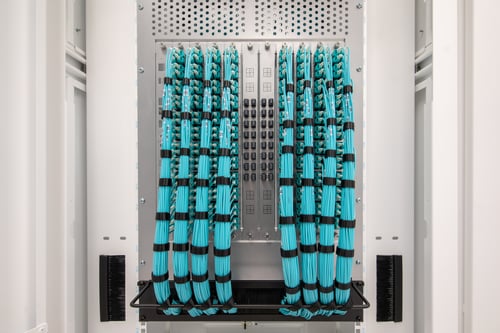The Impact of Fiber Optic Cables on Data Center Energy Efficiency and Cost Savings

Energy efficiency in data centers is a critical concern given the exponential growth in data processing demands worldwide.
Cushman & Wakefield reported in its 2023 Global Data Center Market Comparison that the 11,000 data centers around the world used 7.4 GW last year compared to 4.9 GW in 2022 and that all the extra energy used was expensive with utility costs rising by a median of 16 percent.
“This is a 50 percent increase (!!!) over 2022’s 4.9 GW attributed to data centers. This is difficult for most people to grasp, but that’s the equivalent of powering 6.5 million average American homes,” explained Data Center Knowledge Editor in Chief Wendy Schuchart. “The appetite for power will grow along with the expanding data center landscape and with the cost of power going up, finding cheaper ways to keep the lights on is job one for the data center leadership or be blamed for a future power shortage.”
Infrastructure can play a pivotal role in data center energy efficiency, starting with the cables employed where fiber optic cables present a paradigm shift in energy consumption compared to traditional copper cables.
Fiber optic cables are more energy-efficient than copper cables because they require less power to transmit data over long distances. This is because the light used in fiber optic cables experiences much less resistance than the electrical signals used in copper cables.
Bottom line: This means that data centers that use fiber optic cables can save money on their energy bills.
Fiber Optic vs. Copper Cables: Tale of Two Signals
The choice between fiber optic and copper cables significantly impacts data center energy efficiency and operational costs.
Fiber optic cables transmit data using light signals, which encounter minimal resistance as they travel through the cable's glass or plastic core. In contrast, copper cables rely on electrical signals, which are susceptible to electromagnetic interference and signal attenuation over long distances.
One of the primary energy efficiency advantages of fiber optic cables is their lower power requirements for data transmission.
The light signals used in fiber optic cables experience minimal attenuation, allowing data to travel longer distances without the need for frequent signal amplification or regeneration. This reduces the energy consumption associated with signal-boosting equipment, resulting in cost savings and operational efficiency for data center operators.
Additionally, fiber optic cables offer superior data transmission speeds compared to copper cables. The higher bandwidth capacity of fiber optic cables enables data centers to handle increasing volumes of information without sacrificing performance. This enhanced data throughput contributes to improved operational efficiency and user experience within the data center environment.
Moreover, fiber optic cables exhibit greater reliability and durability than copper cables, reducing the need for maintenance and replacement over time. The resilience of fiber optic infrastructure minimizes downtime and service disruptions, enhancing the overall efficiency and reliability of data center operations.
Long Distance Runs: Fiber Pays Off
The ability of fiber optic cables to transmit data over long distances with minimal signal degradation is a key factor in their energy efficiency and cost-saving benefits for data centers.
Unlike copper cables, which suffer from signal attenuation over extended runs, fiber optic cables maintain signal integrity over considerable distances, reducing the need for signal amplification and regeneration equipment.
The low attenuation characteristics of fiber optic cables result from the optical properties of the cable's core material, typically glass or plastic. Light signals transmitted through the fiber optic medium experience minimal loss as they travel, enabling data centers to establish high-speed connections across vast geographic regions without compromising performance or reliability.
Fiber pays off in several ways:
- The inherent scalability of fiber optic technology allows data centers to expand their network infrastructure without incurring significant energy overhead.
- By deploying fiber optic cables for long-distance communication links, data center operators can accommodate growing data traffic demands while optimizing energy consumption and operational costs.
- The reliability of fiber optic connections over long distances reduces the risk of data loss or corruption during transmission, enhancing data center security and resilience.
- The robustness of fiber optic infrastructure ensures consistent performance across geographically dispersed locations, supporting mission-critical applications and services.
Fiber Means Flexible Network Architecture
The flexibility of network architecture afforded by fiber optic cables enhances data center efficiency and operational agility.
Unlike traditional copper cables, which impose limitations on network design and scalability, fiber optic infrastructure enables data centers to adapt to evolving technology trends and business requirements.
Fiber optic cable advantages include:
- The ability to support multiple communication protocols and transmission formats simultaneously. This versatility allows data centers to integrate diverse networking technologies and accommodate heterogeneous computing environments without compromising performance or reliability.
- Fiber optic cables offer greater bandwidth capacity and spectral efficiency compared to copper cables, enabling data centers to deploy high-speed, high-density network configurations. This increased bandwidth scalability empowers data center operators to meet growing data traffic demands while optimizing infrastructure utilization and resource allocation.
- The lightweight and compact nature of fiber optic cables simplifies cable management and installation procedures within data center environments. The reduced physical footprint of fiber optic infrastructure minimizes space requirements and alleviates congestion in network pathways, enhancing airflow and cooling efficiency.
- The low latency characteristics of fiber optic communication contribute to improved application performance and responsiveness within the data center ecosystem. By reducing signal propagation delays and transmission latency, fiber optic cables facilitate real-time data processing and latency-sensitive applications, enhancing overall system efficiency and user experience.
Lightweight and Compact Equal Cost Savings
The lightweight and compact design of fiber optic cables translates into tangible cost savings and operational efficiencies for data centers.
Unlike traditional copper cables, which are bulky and require extensive structural support, fiber optic cables offer a streamlined form factor that reduces installation complexity and material requirements.
One of the primary cost-saving benefits of fiber optic cables is their reduced infrastructure footprint within data center facilities. The compact size and lightweight construction of fiber optic cables minimize space requirements for cable routing and management, allowing data center operators to maximize rack density and floor space utilization.
Other advantages built into the design of fiber optic cables:
- The simplified cable management afforded by fiber optic infrastructure reduces installation time and labor costs associated with network deployment and maintenance.
- The ease of handling and maneuverability of fiber optic cables streamline installation procedures, minimizing downtime and operational disruptions during infrastructure upgrades or expansions.
- The lightweight nature of fiber optic cables contributes to lower shipping, transportation, and logistics costs compared to traditional copper cables.
- The durability and resilience of fiber optic cables minimize the need for frequent replacements and repairs, reducing lifecycle costs and total cost of ownership over time.
- The robust construction of fiber optic infrastructure ensures long-term reliability and performance, mitigating the risk of downtime and service interruptions.
In conclusion, the superior long-distance transmission capabilities of fiber optic cables contribute to their energy efficiency and cost-saving advantages for data centers. By minimizing signal attenuation and enabling reliable connectivity over extended distances, fiber optics empower data center operators to build scalable, high-performance networks that meet the demands of modern digital infrastructure.
Subscribe to News
Recent posts
LATEST NEWS
Tuesday April 16, 2024







